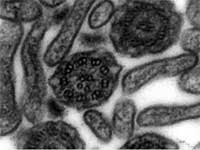Difference Between Cilia and Microvillus

Human Nasal Cilia
Cilia vs. Microvillus
Cilia are tail-like projections found only in eukaryotic cells (that is, the cells of animals). There are two types: motile (that is, mobile) and non-motile. The two functions of these types of projections are to either move through the cell or to act as sensory organisms. Along with flagella, these projections are part of a group of organelles (that is, cell parts) known as undulipodia.
Microvilli are cellular membrane protrusions that increase the surface area of eukaryotic cells. The main functions of these organelles are absorption, secretion, cellular adhesion, and mechanotransduction (that is, when cells convert mechanical stimulus to chemical activity).
Motile cilia are used to move cells throughout certain parts of the organism –mostly animals and a few plants. The cilia act as sweepers, moving objects throughout the body. In mammals, for example, cilia are found along the lining of the trachea and are used to sweep mucus and dirt out of the lungs. Non-motile cilia are usually found in the eyes and the nose (to trap dirt and other objects. In the nose, the non-motile cilia act as olfactory sensors).
Microvilli, on the other hand, are only non-motile, acting in conjunction with the sensory organs of the body –the nose, mouth, and ear in particular. They also act as anchors for sperm cells that have penetrated the extracellular coat of the egg cells.
The structures of both cilia and microvilli differ a great deal, mostly in how they are anchored on certain parts of the cell. Non-motile cilia contain a basal body (a microtubule) that attaches the cilia to the cell body. Microvilli are constructed of a densely packed bundle of cross-linked actin filaments to provide the structural core. A myosin 1a protein and calmodulin attaches the microvillus to the plasma membrane.
The main difference is in the function and movement of the organelles. Cilia, though there are those that do not move throughout the cell body, do ‘wave’, essentially, to move the cell or to move material over the surface of the cell. Microvilli never move. The sole purposes of this organelle are to enhance the surface area of the cell and to increase the rate of diffusion of materials into the cell.
Summary:
1. Cilia come as either motile or non-motile organelles; microvilli never move.
2. Cilia are used to move the cell or to move objects over the surface of the cell; microvilli enhance the surface are of the cell and increase the rate of diffusion of materials into the cell.
- Difference Between AJAX and PHP - December 10, 2009
- Difference Between Abstract Class and Interface - December 10, 2009
- Difference Between Odds and Probability - December 5, 2009

That still doesn’t really help me. They both look the same on a slide. Both nonciliated columnar epithelia and ciliated columnar look the same to me. Can you give a diagram and show me how to tell the difference under a microscope?